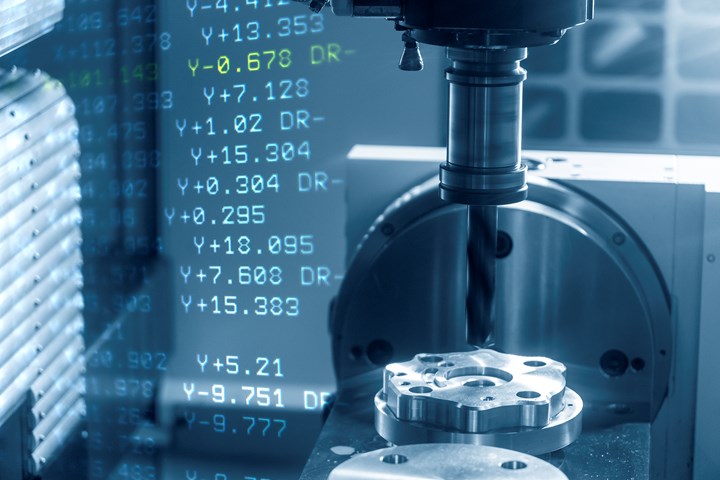3 Mistakes That Cause CNC Programs to Fail
Despite enhancements to manufacturing technology, there are still issues today that can cause programs to fail. These failures can cause lost time, scrapped parts, damaged machines and even injured operators.
Modern CNCs are much more forgiving than their early predecessors. In the old days, everything had to be just so. Before program formatting enhancements, programmed values required fixed formats (without decimal points), circular commands required cumbersome directional vectors (instead of simple radius specifications) and every command had to contain the same number of characters (before word address programming). Before tool length compensation, programmers had to know the exact length of every tool for a program could be created. Before floating zero, all coordinates had to be specified in incremental mode. And before absolute position encoders, every axis had to be in a planned starting position before the program could be run. The list of simplifying enhancements over the years is a lengthy one.
Even with all the improvements, there are still issues today that can cause programs to fail. These failures can cause lost time, scrapped parts, damaged machines and even injured operators. Three things to watch for are: (1) program formatting mistakes, (2) process mistakes and (3) setup mistakes.
While modern CNCs are quite flexible, there are still issues that will keep you from being able to load or run them. With a FANUC CNC, for example, the letter O is used to specify a program number. Simply mistaking the letter O for the number 0 in a program, which is a common beginner’s mistake, will make the CNC stop loading the needed program and start loading another program whenever a letter O is encountered. A similar mistake that can lead to program loading issues is mistaking the lower-case L (l) for the number 1.
Once a program is successfully loaded into the CNC memory, there are still syntax mistakes that will generate errors when the program is executed. Leaving out the radius designator (usually an R word) in a circular motion command is one of many examples.
With currently available program preparation methods, there is really no excuse for having program formatting issues at the machine. Properly configured computer-aided manufacturing (CAM) systems and tool-path plotters can verify that G-code programs will load properly and, once loaded, that they will run without generating errors.
Inconsistencies in programming methods can also lead to problems at the machine. Many CNC features can be handled in multiple ways. With tool length compensation, for instance, the tool length offset can represent the cutting tool length or the distance from the tool tip to the Z-axis program zero surface. Offset entries must match the chosen method. Choose one method and stick to it for all cutting tools in a program, programs running on a given machine and machines used by the company.
In similar fashion, cutter radius compensation allows the programming of either the cutter’s centerline path or the work-surface path — and offset entries must be appropriate to the chosen method. Again, pick the method that best suits your company and stick with it.
Next up are process mistakes. The manufacturing process encompasses anything that affects how components are produced. Of special importance to multi-tool, metal-cutting CNC machines like machining centers and turning centers is the order by which machining operations are performed. One common rule of thumb is that all roughing operations should be done prior to any finishing operations. Breaking this rule often results in a process that will not consistently allow the production of acceptable workpieces.
While not something that will cause a program to fail, a poor process can lead to inefficiencies. Cutting tool and fixture selection must relate to the number of workpieces being produced. What is appropriate when running a lot of fifty workpieces probably will not be efficient enough when running thousands of workpieces.
Another process-related issue that can cause program issues is the improper selection of cutting conditions, including depths of cut, speed and feedrate. If cutting conditions are too aggressive, of course, cutting tools will wear out quickly or break. If they are too conservative, efficiency will suffer.
Finally, consider setup mistakes. There are many things a setup person does while getting the machine ready to run a job that affect the way a program will run. This means that even a proven program (one that has been successfully run many times before) will fail if mistakes are made during setup.
Many setup mistakes may be obvious, like fixture/jaw/clamp placement and cutting tool assignments. If they go undetected during the program’s verification, however, the results could be disastrous.
Other setup mistakes are related to offset settings. For machining centers, the lengths of all cutting tools must be properly measured and entered into corresponding tool length compensation offsets. Likewise, the radius of all side-cutting end mills must be measured and entered into corresponding cutter radius compensation offsets. Program zero assignment values must be properly determined and entered into work coordinate system setting offsets. Similar offset entries must be correctly done when making turning center setups.
Read Next
The Cut Scene: The Finer Details of Large-Format Machining
Small details and features can have an outsized impact on large parts, such as Barbco’s collapsible utility drill head.
Read More3 Mistakes That Cause CNC Programs to Fail
Despite enhancements to manufacturing technology, there are still issues today that can cause programs to fail. These failures can cause lost time, scrapped parts, damaged machines and even injured operators.
Read More
.jpg;width=70;height=70;mode=crop)










.png;maxWidth=300;quality=90)









